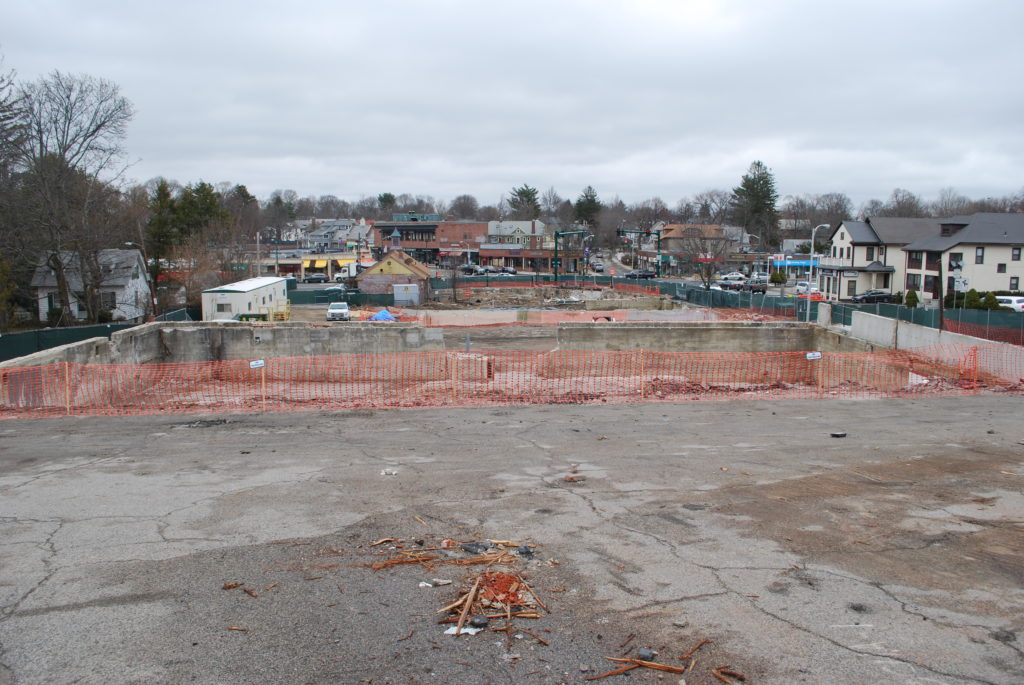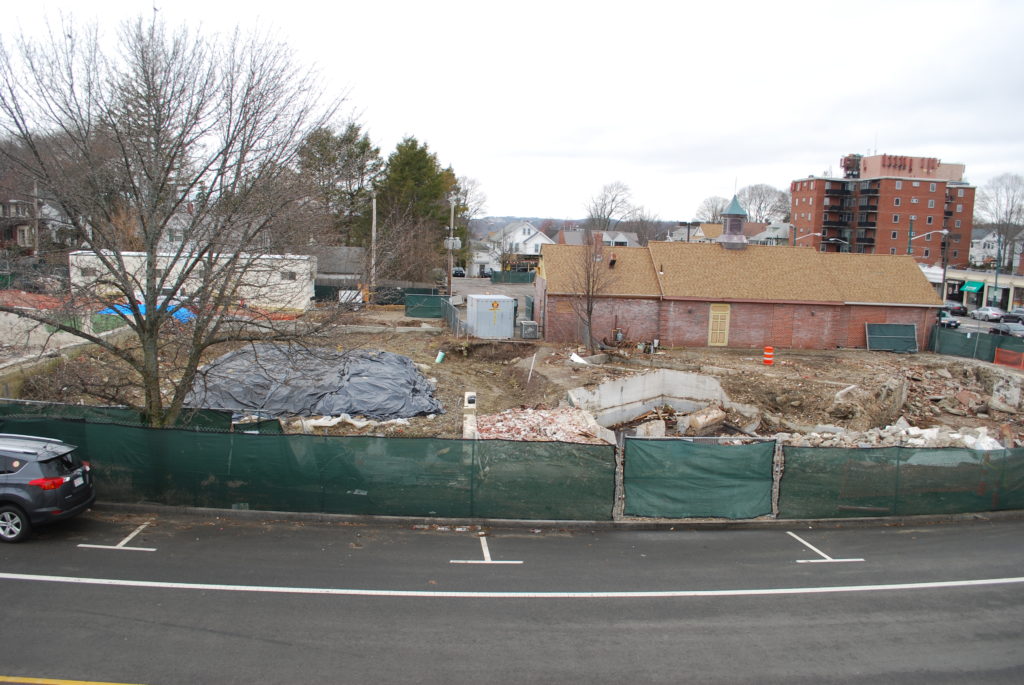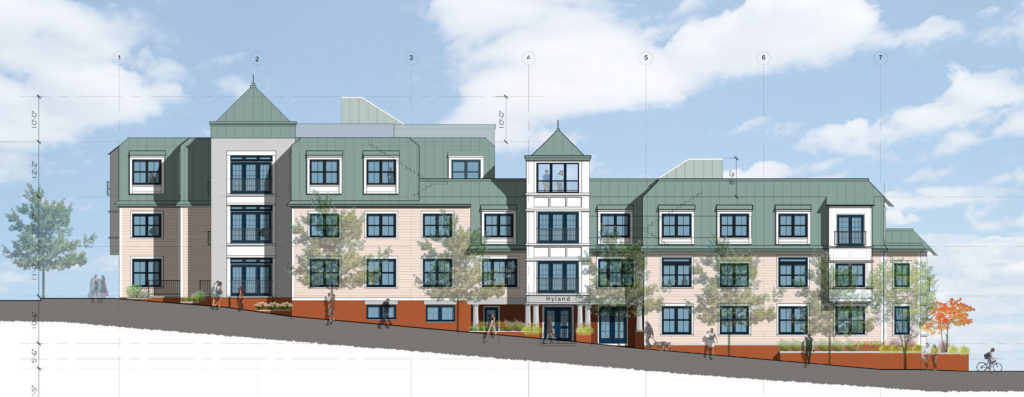Hoping The Cleanup Is Clean
by Virginia Jordan and John DiCocco

By early March, the demolition of the above ground structures was complete. This was shot from Belmont Street, looking down the hill toward Cushing Square. Starbucks, in the middle left of the photo, will come down later. (John DiCocco photo.)
“The CVS has come down.”
Or for Belmont residents of a certain age, “Highland Farms,” or even “the A&P” has come down. Each of these businesses once occupied the building at 527 Common Street (at the corner of Belmont Street). But that 6,200 square foot space in Cushing Square has been left vacant for years.
Acton resident and developer Chris Starr, operating as Smith Legacy Partners LLC, owned that parcel, and with it and other parcels he acquired, created the initial proposal for the Cushing Village development in 2012. Eventually he decided against pursuing the project and in September 2016, sold the properties to Toll Brothers Apartment Living, operating as Belmont Residential, LLC. Starr has retained rights to manage the commercial space once it opens.
On February 1, 2017, Toll Brothers began tearing down the existing buildings to make way for new construction, which will consist of three residential buildings and a parking garage. The first floor of each building will include retail or office space.
Demolition of the above-ground structures at the Cushing Village site is almost complete as of this writing, except for the Starbucks building which will come down later. Removal of foundations, however, will disturb contaminated soil on the site, and therefore is scheduled for mid-to-late March, after the state Department of Environmental Protection (DEP)approves a technical abatement plan.
Concerns About Contamination
There are considerable neighborhood concerns about environmental remediation and potential air and groundwater contamination from the site, which has been polluted by various businesses, such as a dry cleaner, over the years.
Each phase of demolition, excavation, and construction requires approval from DEP.
It is not clear when the site will be deemed fully clean, or at least safe to build upon. Each phase of demolition, excavation, and construction requires approval from DEP.
On February 27, the town and the Cushing Square Neighborhood Association (CSNA) met with Sage Environmental, Inc., the firm monitoring the air, soil, and water quality at the site on behalf of Toll Brothers. Sage, represented by Molly Cote and licensed site professional (LSP) Jacob Butterworth, shared the head table with representatives from Toll Brothers and Glenn Clancy, Belmont’s community development director. In January, Sage released the draft Release Abatement Measure (RAM) Plan, a complex document running more than 700 pages, for public and town responses.

A partial view of the site from Common Street. The side of the Starbucks building, formerly Friendly’s, is at right, and will come down later. (John DiCocco photo.)
The More Eyes, The Better
CSNA’s primary focus is ensuring that contamination and exposure for nearby properties and the people who live or work in them has been adequately measured and described. It will also report on progress and problems to affected residents.
Not one but two professionals have reviewed the plan at this stage. To further protect the interests of residents, the town hired an independent LSP, John Thompson of Waypoint Environmental LLP, to provide a detailed analysis of Sage’s findings. Doug Koplow, one of the leaders of the CSNA, noted, “John flagged an array of significant issues regarding testing methods, data, delineation of the boundaries of the contaminated area, protection of residents during removal of contaminated soil, etc. The town is well served by having this level of oversight at this stage in the process.” Clancy says the town has funds to continue to engage Thompson if needed.
Particularly important to local residents was the potential dust inhalation risk, given the pollutants still in the ground.
Additionally, Jim Decoulos, a Belmont resident and an LSP himself, examined the proposed remedial process. Koplow says, “On his own time, he carefully reviewed the draft RAM plan and submitted comments to Sage Environmental. Among the most important of his findings was that the indoor air testing done to see if migrating plumes of volatile chemicals were entering stores along Trapelo Road was insufficient to determine hazard levels. Testing needs to be done during winter months as well; he recommended immediate retesting. He also noticed the problems with delineating the boundaries of the contamination, and with the process of soil remediation.”
Particularly important to local residents was the potential dust inhalation risk, given the pollutants still in the ground.

Artist rendering of the Cushing Village’s Hyland Building, to be situated on Common Street. (Toll Brothers drawing.)
Sage Meets with Public
Both Thompson and Decoulos attended the February 27 meeting, along with about two dozen residents. At the meeting, Cote and Butterworth discussed how Sage will address items of concern during the comment period, before issuing the final RAM. The conversations were informal, informative, and friendly. Particularly important to local residents was the potential dust inhalation risk, given the pollutants still in the ground.
Koplow wrote in a summary letter to CSNA the following morning, “As we have been informed by people who saw the buildings come down that dust control during the demolition of the above-ground structures was not particularly robust, the importance of getting these things right now is all the more important. Sage Environmental will respond to key issues in writing during the comment period. We expect in some places this will result in changes to their plans that are more protective of residents.”
Building Gone, Hazard Remains
A major concern at the site is the pollution left behind by Tops Cleaners at 495 Common Street, which years ago was declared a hazardous waste site and torn down.
The DEP database on the Tops Cleaners site (Release Tracking Number 3-0023300) dates back to September 14, 2006, and has a troubling 55 occasions of filings (many of them multiple documents). The filings include a finding that “soil and groundwater within the former Tops Cleaners parcel . . . was impacted by spills of dry cleaning-related solvents and is impacted with trichloroethylene (TCE) and tetrachloroethylene (PCE).” The building was demolished, and the soil pile of hazardous waste was treated in 2010, but it still requires more remediation.
Sage has indicated that a liquid neutralizing agent will be poured in, and the entire process will take at least six weeks. If the DEP declares the neutralization successful, Toll can ship and dispose of it less expensively as nonhazardous waste.
Throughout the demolition and construction, Sage is operating air monitors, and states they will alert the town health department of any rise in unacceptable air quality. Citizens at the meeting continued to express concern about the placement and accuracy of these monitors. Toll Brothers is also keeping a water truck on site for dust abatement.
More Trouble Across the Street
Recent site assessments found elevated contamination samples in some places on the north side of Trapelo Road. This may be migration from the plume on the Cushing Village site or possibly from other businesses that used to operate on Trapelo Road. According to town photos there were two cleaners on the north side of Trapelo for periods between 1949 and 2007.
“The data on where the perimeter of the Cushing Village site contamination ends remains murky.”
“The data on where the perimeter of the Cushing Village site contamination ends remains murky,” Koplow wrote in an email to the CSNA group, “and is one of the main critiques we have of the draft RAM plan. There has been very little offsite testing for contamination, even though at least parts of this site have been on DEP’s lists since 2001 or 2002.”
Once, It Was Clean
At the turn of the 20th century, the building on the corner of Trapelo Road and Common Street was an SS Pierce building. The February 23, 2017, Belmont Citizen-Herald, reporting on the history of SS Pierce, noted that the previous Country Store on that site (the Cushing Village site) was called the Spring House, because it sold water from a nearby spring. Thus, as late as 1905, water in that area was apparently clean enough to drink. No one is drinking from that water source today.
Belmont Citizens Forum will provide updates as this project moves forward.
Virginia Jordan and John DiCocco are editors of the Belmont Citizens Forum.


Sorry, the comment form is closed at this time.